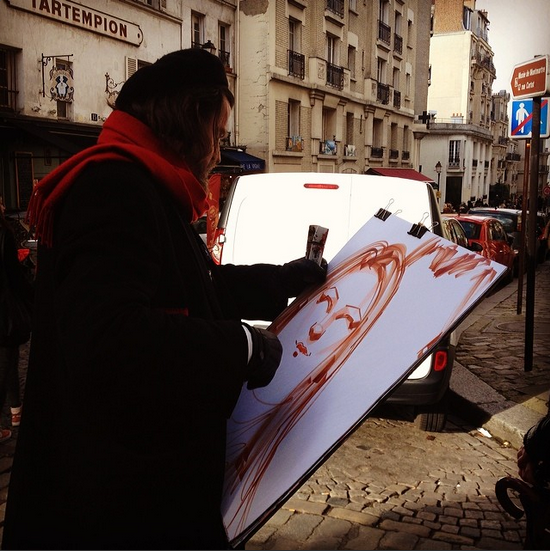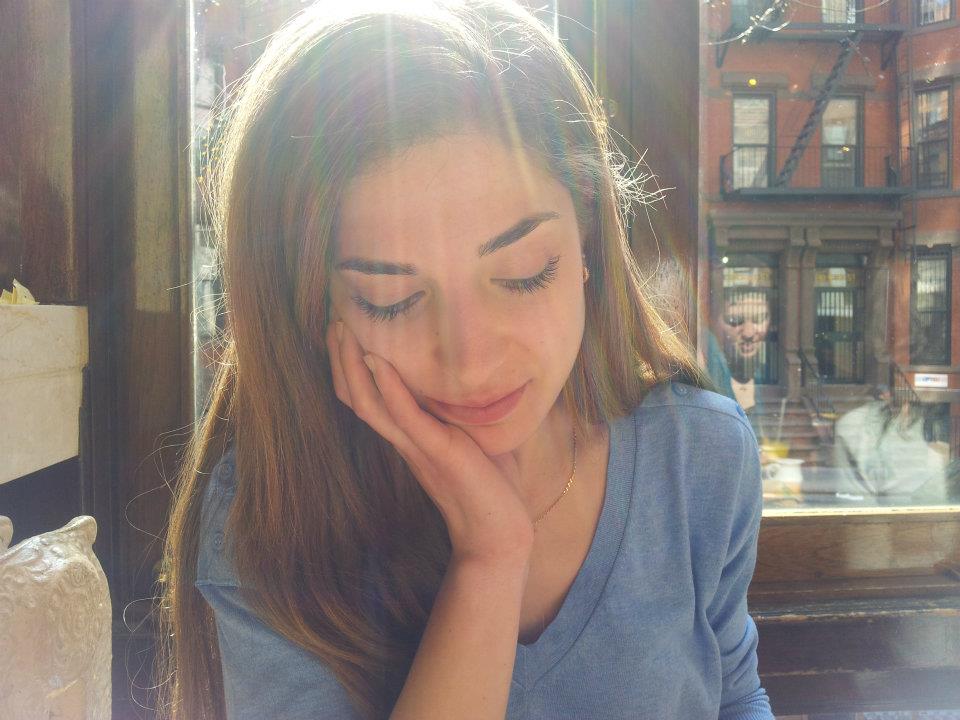Tags
Alexandre Privat, Apollinaire, Aristotle at Afternoon Tea Yara Zgheib, Baudelaire, Czech Republic, Dictionnaire de l'Academie Française, Françoise Sagan, George Sand, Giacomo Puccini, Honore de Balzac, Jules Valles, La Boheme Henri Murger, Rimbaud, Scenes de la vie de boheme Henry Murger, Verlaine, Yara Zgheib
Share it
 On Doing and Being by Yara Y. Zgheib. © 2014 Yara Y. Zgheib. Published with permission. All rights reserved.
On Doing and Being by Yara Y. Zgheib. © 2014 Yara Y. Zgheib. Published with permission. All rights reserved.
It is a beautifully clear day despite the freezing cold, and mon chéri is napping on the couch beside me. Charles Aznavour and I are singing la bohème just low enough not to wake him, and I am thinking back to a cold little closet of a room we once lived in on the sixth floor of a crumbling building in Paris’s 14ème arrondissement.
La bohème. It was French novelist Henri Murger who first romanticized the expression in his 1847 novel, ‘Scènes de la vie de bohème.’ The term originally designated a region in what is today the Czech Republic, inhabited then by a poor, nomadic group called Gypsies or Romany. But with Murger it came to mean ‘a world of artists, social rebels, and radicals who rejected the comforts of the bourgeoisie, opting instead for poverty, and believing that any true experience demanded suffering. They were committed to a life of freedom, work, and pleasure, and eschewed the corruption and rotten values of conventional society.’
Bohemianism caught on among writers, composers, and artists in the nineteenth century: Giacomo Puccini, Alexandre Privat, Jules Vallès, George Sand, Honoré de Balzac, Baudelaire, Rimbaud, Verlaine, Apollinaire… In 1932, the Dictionnaire de l’Académie Française even issued a new definition for the word bohemian: ‘One who lives a vagabond, unregimented life without assured resources, who does not worry about tomorrow.’
Trust the Parisians to elevate starving to death to an art form.
Murger lived in different times, when status was predetermined by birth and philosophy could be a profession. A time when there was romance in the notion of voluntary poverty. Today, the world is industrialized, monetized, and mass-produced, and when you are not born to privilege, wealth, or status, la bohème is a luxury you cannot afford. Just ask the 5.9 billion citizens of developing countries and the 38.5 million immigrants in the United States. The only guarantee of security, and survival, is hard work.
Forget about art, forget about poetry. Choose a noble profession. Once upon a time that term designated clergymen, educators, and doctors. Today it refers to any sought-after job that requires an education, is performed in a soil-free office environment, and offers enticing socio-economic returns. Trade in your passion for a white collar, your happiness for security. The sky may be the limit, but in this day and age you are what you do; how many cowboys and ballerinas do you know anyway?
I do not blame parents for wanting solid futures for their children. I do not blame them for raising a generation of overachieving lawyers, doctors, bankers, and engineers. Poverty is exhausting, and only in a Hemingway novel is there any romance in going to bed hungry and cold. But I do blame society for its twisted, shallow association of profession with worth. I blame it for dictating people’s lives by the white or blue color of their shirts. I blame it for ruining la bohème.
More than a century after Murger, Françoise Sagan wrote of a world where, instead of asking people what they did, she asked them if they were in love, what they were reading. Imagine what that would look like: a world where being an artist or a banker, a grocer or a physician, a musician or an engineer, was only a byproduct to being happy. A world where we were less concerned with what we were and more with who we were.
Perhaps la bohème was never about starving to death at all. Perhaps, as Aznavour so simply put it, it only meant on est heureux.*
Professions are not noble. People are. Those who do what they love, and those who find happiness in whatever they do.
Here’s to those who make our bread, those who make our music, and those who make us dream. To happiness. To la bohème.
* ‘We are happy.’
 Born in Lebanon, Yara Y. Zgheib has traveled and lived in Glasgow, Washington D.C., and Paris, the city that forever has her heart. She is a Fulbright scholar with a Masters degree in security studies and an all but completed PhD in international affairs and diplomacy. More importantly, she is a writer, a political analyst, a daydreamer, and an avid tea drinker.
Born in Lebanon, Yara Y. Zgheib has traveled and lived in Glasgow, Washington D.C., and Paris, the city that forever has her heart. She is a Fulbright scholar with a Masters degree in security studies and an all but completed PhD in international affairs and diplomacy. More importantly, she is a writer, a political analyst, a daydreamer, and an avid tea drinker.
Yara is the author of “Biography of a Little Prince,” and has a second novel, “Letters I’ll Never Send,” scheduled for release in 2015. Her blog, “Aristotle at Afternoon Tea,” is a compilation of weekly essays on politics, art, culture, economics, literature, philosophy, and chocolate… her idea of a smart conversation over afternoon tea. For more information about Yara, visit: (Aristotle at Afternoon Tea)
You may also enjoy A Woman’s Paris® post Photo-ready in Paris: not what you might expect. Barbara Redmond takes you from Café de Flore to rue Bonaparte to Place de Furstenberg in Paris as fashion photographer and author Frédérique Veysset’s Nikon clicked frame after frame, shooting faster and a lot, in the action without posing. Fixing on a place and time that was Paris. (French)
Paris photo shoot in search of the perfect Moroccan slipper, by writer Lisa Rounds who tells of her adventures in the North African neighborhood of Barbès in Paris searching for the perfect slipper in red, of course, for a Cosmo photo shoot. Lisa shares her story of “living the dream,” working for a publishing company in Paris.
Ballet Flats in Paris: And God made Repetto, by Barbara Redmond who shares what she got from a pair of flats purchased in a ballet store in Paris; a feline, natural style from the toes up, a simple pair of shoes that transformed her whole look. Including the vimeos “Pas de Deux Coda,” by Opening Ceremony and “Repetto,” by Repetto, Paris. (French)
Finding boubous, taibas, and myself in Sénégal, by Ashley Steele, an African American and student of French, who wanted to explore a non-Western culture and its perspective where she found a deep meaning once she stepped foot on African soil.
French Lingerie: Mysterious and flirty, by Barbara Redmond who shares her experience searching for the perfect lingerie in Paris boutiques and her “fitting” with the shop keeper, Madame, in a curtained room stripped to bare at Sabbia Rosa. Including a French to English vocabulary lesson for buying lingerie and a directory of Barbara’s favorite lingerie shops in Paris. (French)
Doing the bridge “faire le pont” in Paris by Parisienne Bénédicte Mahé. Every year, the month of May is full of promises for people working in France: the promises of numerous public holidays. Between May 1st and May 8th we look for maybe three four-day weekends. Because what is a French person to do, except take Friday off when Thursday is a public holiday? In French we call that faire le pont, “do the bridge”. What do people do during these long weekends? Well…
What’s in a Word? There’s more to French class than you thought. Jacqueline Bucar, French teacher and immigration attorney, invites us to stimulate a way of thinking and learning that expands our understanding of the world and ourselves through the study of a foreign language. She shares “what’s in a word,” a way of thinking, a “mentality” that helps define the people who speak it and their culture. (French)
Text copyright ©2014 Yara Y. Zgheib. All rights reserved.
Illustration copyright ©2014 Barbara Redmond. All rights reserved.
barbara@awomansparis.com


1 comments
John Henry said:
January 30, 2015 at 8:59 am
Correction to Bohemia. My ancestors were from Bohemia, a land inhabited by Bohemians, Moravians and Germans. Gypsies were a very small minority and not the primary inhabitants as the article implies. I am not sure how the association with Bohemians as Gypsies came about, but it is still prevalent today. Ethnic Bohemians in America are aware of the comparison, and do find it humorous, in spite of the negative connotations.
Recently, I had to inform a friend of these historical misperceptions. Thanks for posting this article, it is useful background.